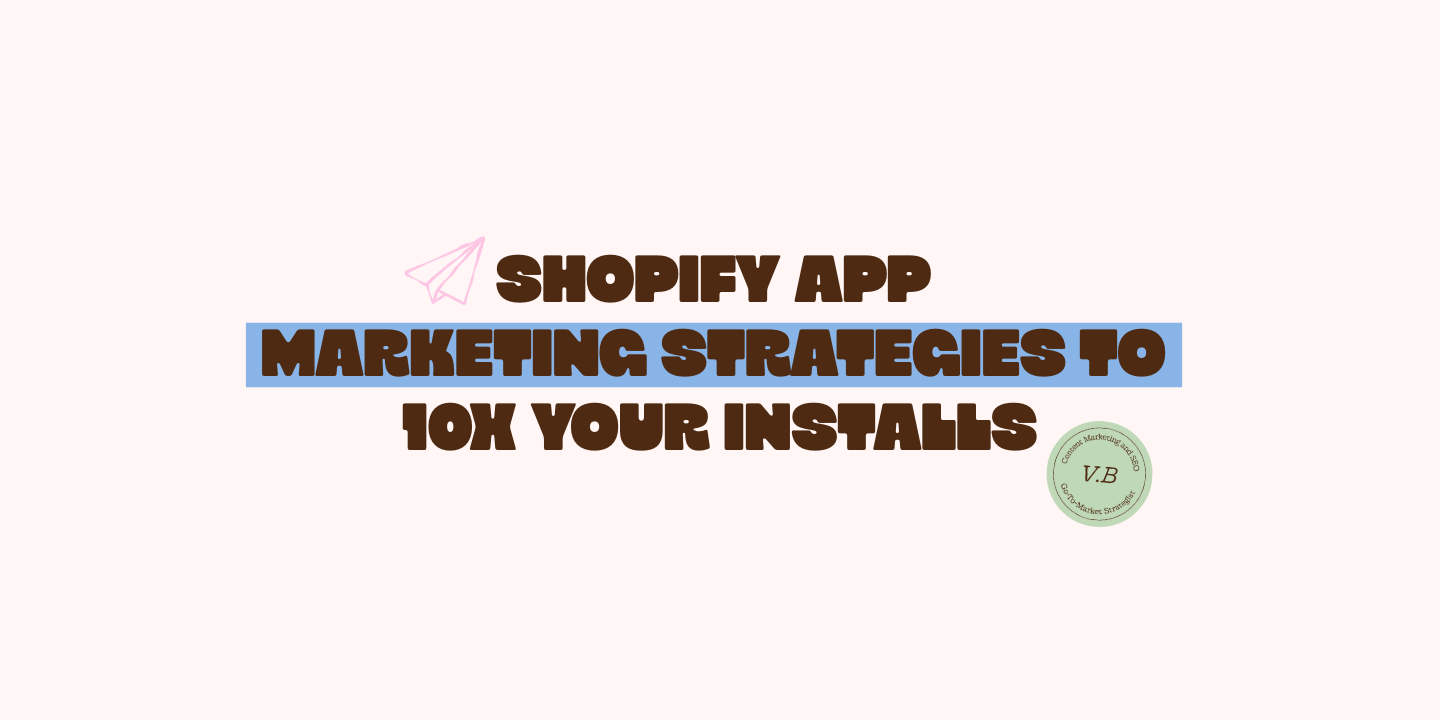Shopify is one of the fastest evolving eCommerce platforms in the digital landscape today. And I don’t just mean for brands that are able to take their products online. I am talking about the business opportunities it provides to products. Right from marketing automation to customer engagement, the Shopify app store gives every B2B offering and model a chance to reach out to online merchants.
But similar to how the number of online stores is increasing by the day and competing for shopper attention, Shopify apps too, struggle to get the right limelight.

While some become a hit instantly for having launched their product at the right time, others struggle to find the right merchant-fit for their product. That’s where it becomes important to go beyond the Shopify ecosystem to market your app and take your product to the merchants with a value proposition that is hard to say no to.
Shopify app marketing tactics you need to pay attention to
Let’s take a look at some of the Shopify app marketing strategies I’ve had the chance to implement for the partners I’ve got to work with:
1. Shopify app store optimization
This one goes without saying. Before starting with any other marketing tactic, it is important to secure the one channel that is sure to get your app discovered amongst merchants across the world – the Shopify App Store.
Your app listing is where a merchant can learn more about your product. It helps them decide if it solves their problems or could help their online store grow faster. So pretty much similar to the Apple App Store or Google Play Store, this listing includes app descriptions, supporting details, pricing structure, and screenshots that help merchants visualize what the product looks like and how it will help them.
So the very first step you need to take here is choosing the right keywords.
Keywords are basically words or simple phrases that define what your app does and are used by merchants to look for solutions in the app store, or on the search engine. While there may be multiple keywords that define what your product does, a good Shopify app marketing strategy is one that narrows down the market to reach a well-defined market.
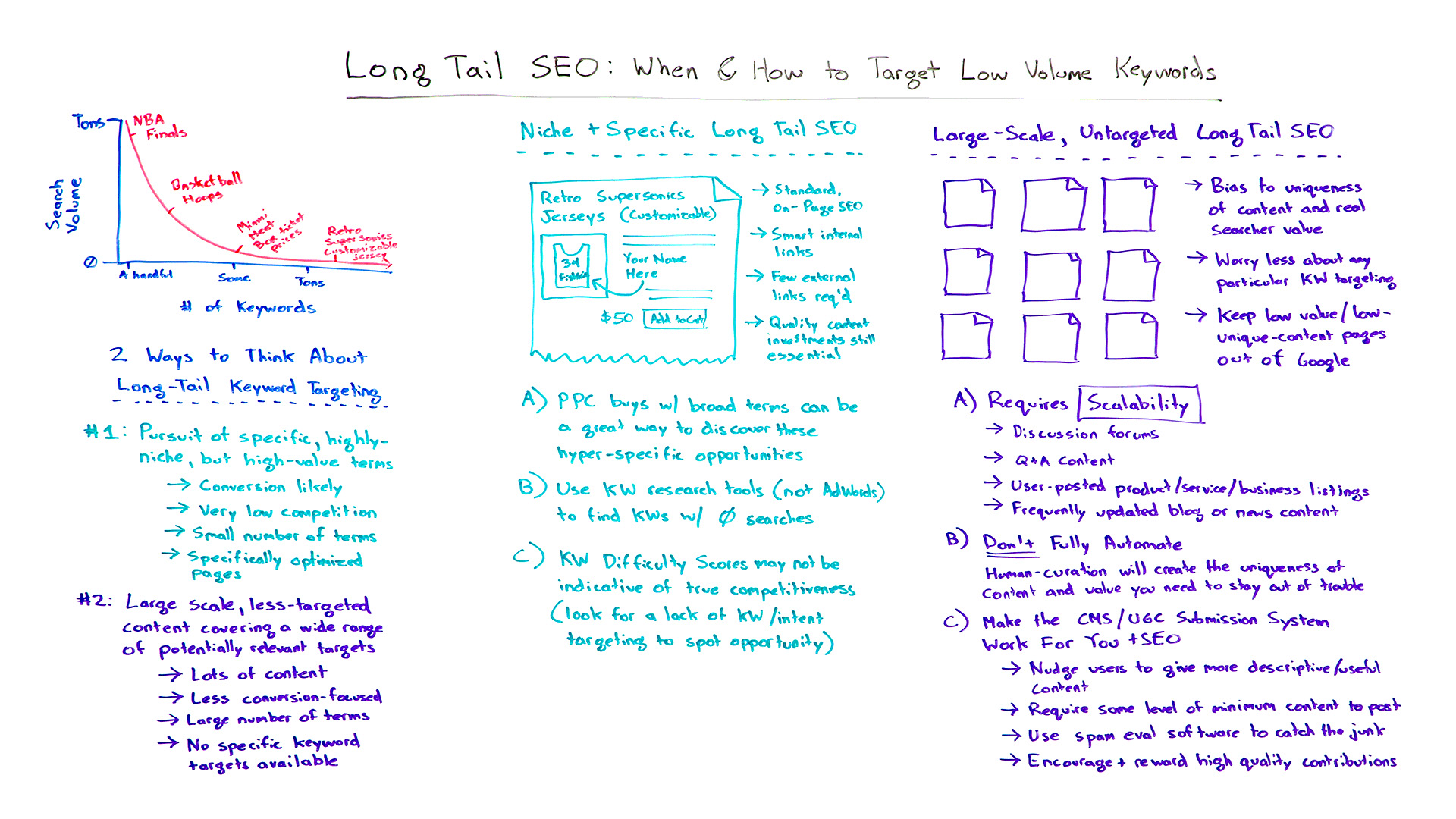
Here’s how to pick the right keywords for your Shopify app:
- Understand your target market and define your customer personas
- Clearly lay out the challenges of your target accounts
- Align your Shopify app’s offering as solutions to the above challenges
- Use Google Keyword Planner to look for words or phrases used to search for solutions on the challenges listed
- Separate out high volume, navigational, intent-based and latent semantic indexing (LSI) keywords
- Shortlist a batch of keywords that are the most relevant to what your Shopify app does and the phrases that are closest to the problem you solve
- Remember to continually analyze the change in search behavior to optimize your keyword strategy
- And most importantly, don’t pick too many keywords!
Once you have your keywords, here are a few things to keep in mind when optimizing your app store listing:
- Don’t overuse the keywords in the app description copy – very important!
- Include variations of your keywords for wider search match (don’t worry about singular or plural forms as the search engine automatically identifies that)
- When using keywords in the description, make sure they flow logically with the sentence
- Include the most important search terms in the app submission form to define what is highly relevant to your Shopify app
- Use the integrations field to state direct integrations only
- Continually test keywords for your app listing
- Make sure you add the best of your app screenshots or design graphics that help merchants visualize your product
- Consider including a product video or a case study video to present your value proposition better
Wait, there’s more.
Shopify even announced localization at Unite 2019 to open global markets for app developers. With localization, your Shopify app marketing strategy can focus on appealing to an audience in 9 other languages other than English – Brazilian, Portuguese, Chinese (Simplified), Chinese (Traditional), Dutch, French, German, Italian, Japanese and Spanish.
What this means is that you can localize your app descriptions to leverage the location-based ‘collections’ that will be displayed to merchants by editors, and be more relatable to the 47% of searches made by a non-English speaking audience.

Psst. To earn more brownie points, localize your in-app content as well!
Pro-tip. Want to take search optimization to another level? Create a landing page or a website for your Shopify app and optimize the content here for the same keywords you’re targeting in the app store.
2. Content marketing
Sorry to burst your bubble if you’ve been thinking about getting away without creating any content. The only way to make sure merchants know about your app or what it does is to provide them with enough information – information that creates a demand and information that fulfills the demand.
Content marketing has proven to generate 69% more leads for businesses as compared to traditional marketing tactics. Considering how the consumer market is becoming more information-driven, the number is pretty self-explanatory!
But I have to be honest, it takes time to show results. Initially, all it will get you are a few website visits. Slowly those website visits will increase and the time each of these users spends on your site will increase.
Eventually, you’ll see subscribers coming in and then you’ll find your content generating leads for your Shopify app – yes, you will be going through all the stages and no, there is no shortcut here.

A few of the content formats that I have seen work beautifully for Shopify apps include:
- Blogs
- How-to guides and Help Docs
- Videos (how-to and use cases)
- Webinars
- Infographics
- Ebooks
- Reports and whitepapers
- Social media posts (easy to consume and super actionable!)
Although, there are a few things that you can do to make sure content marketing works for your Shopify app right from the start:
- Focus on creating content that merchants are looking for – it could be directly around what your app does or a use case that your app can possibly add value to – because if they’re not looking for it, what’s the point?
- Identify content buckets you can add value to – let’s be honest, your target merchants aren’t just looking for things relevant to your app; their searches vary based on what challenges they are facing and they may not all be relevant to what your Shopify app does. So, identify what content buckets you could fill in!
- Create a well-defined content calendar – you may have a lot of ideas in mind, but give your content marketing a direction by creating a calendar. List down the topics you can realistically cover, the keywords you’re targeting for each, the call-to-action you’ll be adding, quick briefs around what the content piece is about and most importantly, for what stage of the customer lifecycle you’re writing the piece.
- Optimize each of your content pieces for the search engine – it might take you a while to get started, but remember to first take out the keywords that you want to rank for and what people are searching for, before writing out any content piece – because if they’re not searching for what you want to rank for, how do you get discovered?
- Don’t just publish, distribute and syndicate too – once you start publishing content, remember it isn’t just about putting out content on the internet; there’s plenty of it already! That’s why you need to focus on distribution and syndication as well. Make sure that once a piece (no matter how short) is published, you don’t wait for merchants to discover it – take it to them. Promote it on social media, on communities, through paid ads or even through content distribution channels like Outbrain.
- Be helpful and be consistent – this one’s more of a rule, less of a step. If you want content marketing to work for your Shopify app, remain patient and just keep helping your target merchants. It might take a while, but when consistent and keyword-focused, it can become the best Shopify app marketing strategy you could ever use!
I found this Twitter thread pretty interesting – for all those who think content takes too long or isn’t reap results, you might want to read this:
SaaStr content marketing learnings from someone that Knew Nothing
– wrote 100 posts to start
– 1 piece of content a day from ’12-’13
– 3 pieces of content a day from ’14-’19
– every day, always
– kill anything you don’t love
– promote anything that makes you smile
– ignore views— Jason ✨????✨ Lemkin ???? (@jasonlk) June 30, 2019
Struggling to syndicate and distribute your content to get more relevant views, or not sure how to get started? Don’t worry, my upcoming post talks about it all and will have all the relevant resources you need. Hit subscribe to get the post in your inbox!
And if you need a little help getting started, let’s talk!
Recommended read: Shopify apps content marketing case studies
3. Search engine optimization (SEO)
Almost 89% of B2B researches still use the search engine to gather information around their business objectives, goals and the solutions available to address them. That’s why despite getting your ASO right is not enough – you also need to optimize your efforts for the search engine.
Similar to how you’re focused on ranking for the right keywords on the Shopify App Store, you need to narrow down your focus on getting discovered for the right phrases on the search engine.
Right from setting up your presence on the internet – your website, to optimizing every aspect of it – text, images, videos, frequently asked questions and more, an SEO strategy will double the impact of every digital collateral you create. By optimizing each for the right keywords, distributing it across channels, communities, groups and platforms, to building contextual backlinks, SEO is what ensures that you’re able to get your content in front of the right people and also help you build an owned audience on the website.
Read the complete guide on B2B SEO here to skyrocket your organic traffic and drive more conversions.
Here’s why I think B2B SEO is as (or more) important for your Shopify app as the Shopify ads or PPC campaigns you’re running:
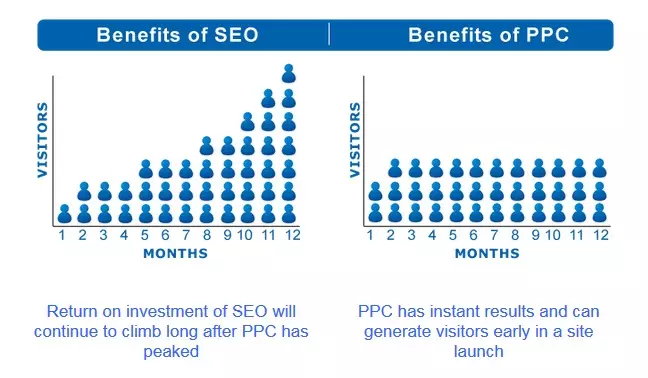
4. Social media marketing
Another tactic I definitely recommend to any of the Shopify apps I work with, is to not miss out on the potential of social media.
With B2B buyers moving to social media to seek solutions or get educated on their challenges, these platforms are not just for the DTC industry.
Think about your target audience and where they spend most of their time – social media; focusing on promoting their products and collections to reach their potential customers.
They are on social media looking at what other brands in the industry are doing to promote themselves, seeking tips to create better eCommerce marketing strategies. Wouldn’t you want to be present when they’re doing research?
While I don’t necessarily recommend posting every day, creating lots of carousels, images or videos, I do recommend working on your presence on the key channels Shopify businesses use to promote their brand – this includes Facebook, Instagram, LinkedIn, X, TikTok, Pinterest and of course, take into account other localized platforms.
Narrow down your focus on a combination of three, build your audience – using educational content and hashtags relevant to what you do as well as the Shopify ecosystem.
While you may not see too many likes, comments and follows coming in organically, the regular posting has gotten the apps I work with noticed and also often receiving special requests from their target audience – and also existing customers.
Here’s an example from SMSBump by Yotpo using social media marketing for their Shopify apps:
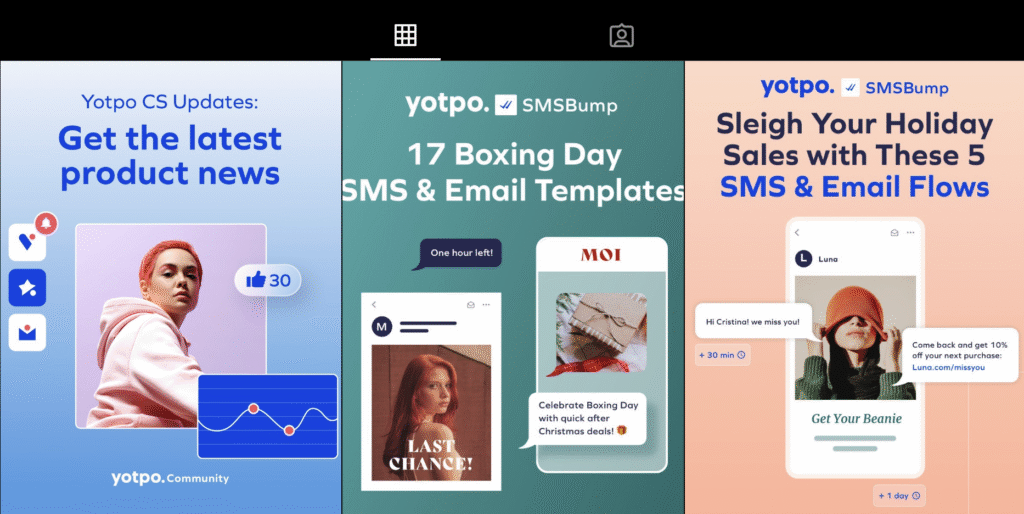
5. Thought leadership Content/ CXO/ Founder branding
Today, there are over 4000 Shopify apps, with new ones coming into the app store every other day.
With the barrier for entry becoming much lower, and of courses the ready resources to build an app becoming available, you can see most developers investing their time and money into building solutions. Don’t believe me?
If you look for an SMS marketing app, here are the options available to you – each with features similar to one another, and a pricing that is forever competing:
And that’s why it’s time to create your own voice in this ecosystem. This is where thought leadership content or Founder profiling comes into play. Instead of only relying on the marketing forefronts you set up for your brand (the app), in this case, you make your own profile on social media, a distribution channel.
The only difference is, that you take a different educational approach that is focused on talking about the industry, current trends, status quo of things, problems – more frequently than talking about your app and its features alone.
Here’s how Appstle, a Shopify subscription app, is using their Co-Founder’s voice on LinkedIn to not just reach their target audience, but show their expertise in the domain, build a partnership network and connect with agencies that can eventually help them reach their ICP:
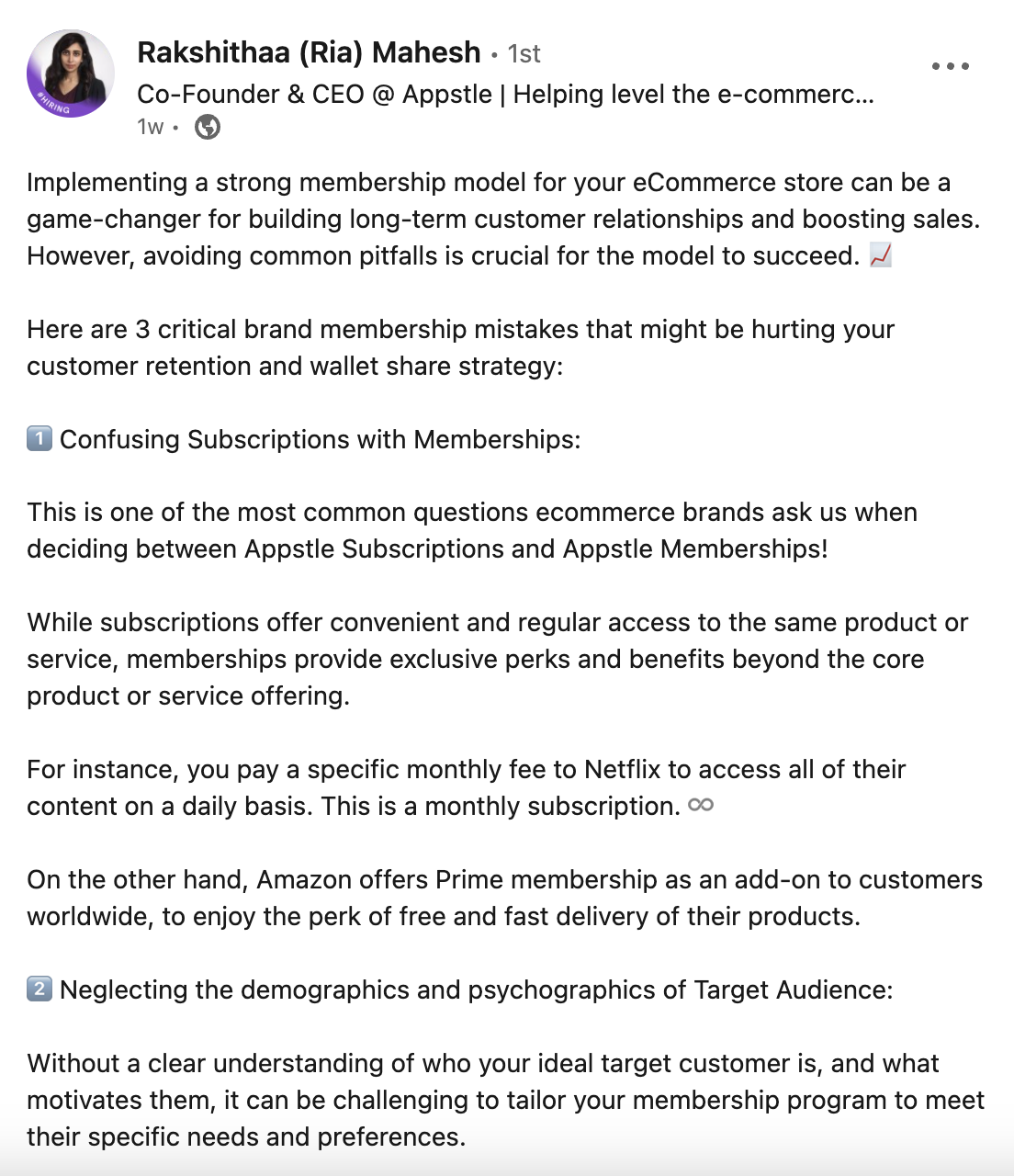
6. Communities and groups
If you’ve been in the Shopify ecosystem for even a month, you’ll know how close-knit the community is. And I’m again not talking about only the merchants. The developers too are all connected to one another, always willing to help each other out. That’s exactly what your Shopify app marketing strategy should include.
Become a part of relevant Shopify communities and groups on LinkedIn and Facebook. Make sure you know the value you take to these groups to be able to start contextual conversations and drive them towards your product – beforehand.
Start by simply being helpful to merchants. Be it around a problem your product solves or something you just know about from industry experience.
Then start looking out for threads that are relevant to what your Shopify app does. Instead of just replying to these threads, promoting your product blatantly, take some time to write a good answer. Focus on talking about the problem mentioned by the merchant and walk them step-by-step through how your Shopify app can help.
And most importantly, don’t just restrict the help to merchants. See if fellow Shopify apps are looking for suggestions you could make. You never know which partnership you might bag through these conversations that lead to acquiring more customers.
Here’s an example of Shashank Kumar, the Founder of PushOwl, contributing to a conversation in a Facebook group. While his Shopify app is all about web push notifications, his answer here remains super relevant and helpful.
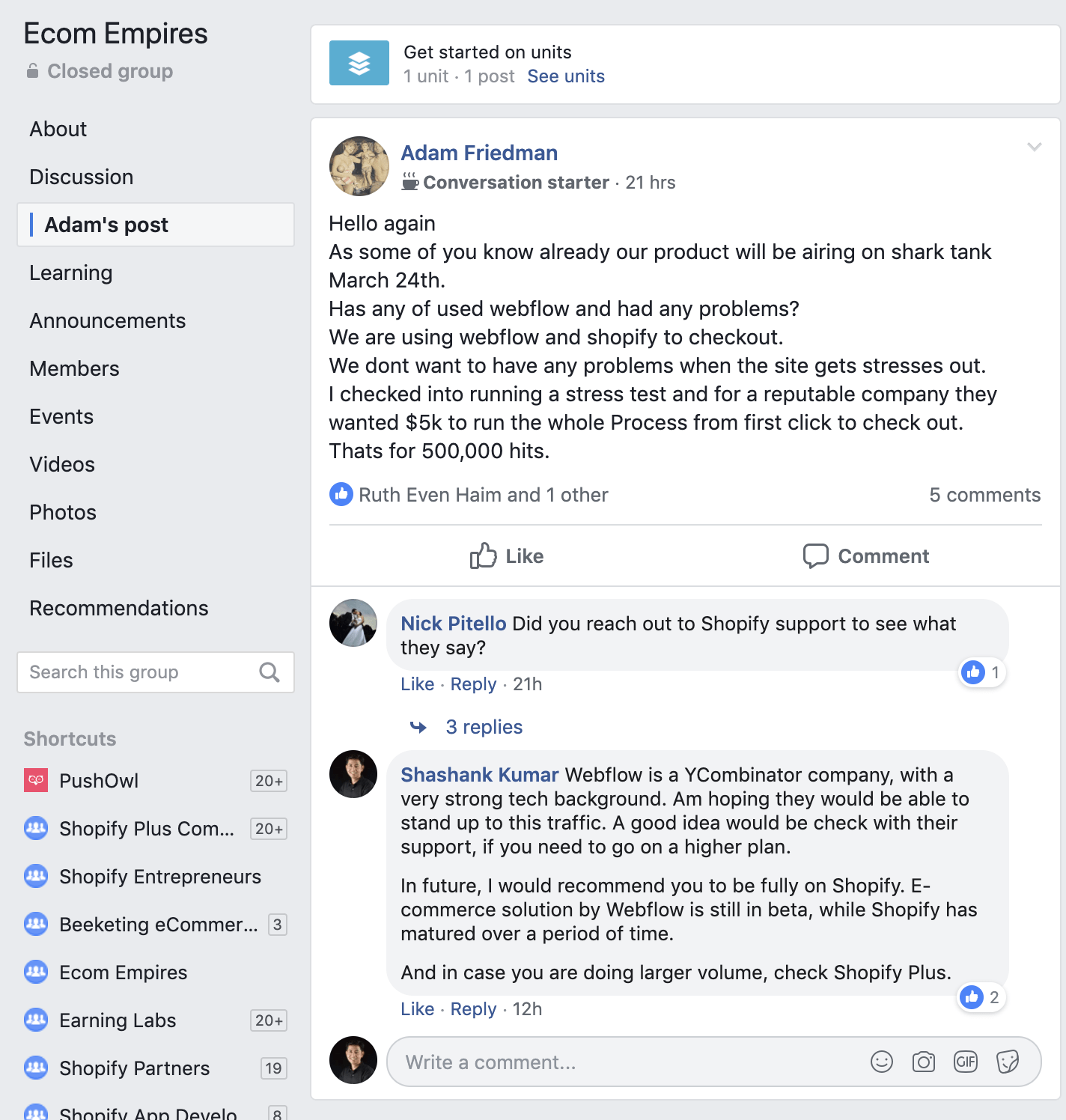
If your app caters to more platforms than Shopify, you can also go on to participate in relevant threads on Reddit and Quora.
7. Co-marketing
Continuing on our point above on bagging a partnership through relevant conversations, the next in your Shopify app marketing strategy should be co-marketing.
By co-marketing, I simply mean reaching out to Shopify apps that have been in the market for longer than yours with a proposal for marketing products together. They market your product to their user base and you do the same in turn.
Of course, in this case, you’ll need to take into account what the Shopify app does – you want to be able to co-market with someone who has a user base similar to your target market, complements what you do but does not pose a competition.
A good way to start this activity is to first focus on networking in the Shopify community. Talk to other app developers to see what they’re doing, how they’re doing it and then pitch co-marketing, or else you’ll just seem desperate to take your Shopify app to the front line.

Once you have good connections and know which Shopify apps you want to co-market with, here are a few activities that you can take up together. These are aimed at not just introducing each other’s products to the already qualified audience, but also gaining engagement on channels like social media.
- Blog post exchange – keep in mind each other’s audience, write keyword-focused content introducing your Shopify app
- Social media post swap – either share the blog posts written or create separate social media graphics to share in a post, where the other app is tagged
- Facebook pixel exchange – a great way to reach a qualified audience that is more likely to convert on seeing the ads – it’s pretty much like swapping your audience/ user base
- Email newsletter promotion – promoting each other’s Shopify app or the blog written in the regular newsletter to subscribers and users
- Webinars – host a webinar together to put forward how merchants can use your apps; remember to invite your existing subscribers and users
- Video marketing – similar to webinars create a video together that showcases a use case together to solves a merchant’s challenge
I’ll be talking about how to go about each of these co-marketing activities much in details in the coming blogs. Don’t forget to tune in or simply subscribe to get the posts in your inbox!
8. Cold emailing
Before you say, ‘hey, we shouldn’t barge into someone’s inbox like that!’, hold on.
Cold emailing still works. It only becomes spammy when you have absolutely no idea about who you’re talking to and what value you can bring to them. But when you do, your Shopify app marketing becomes 10X faster at achieving its goals because you’re able to start meaningful conversations with merchants and walk them through the value you bring to their online store.
Now similar to other Shopify app marketing tactics, cold emails require a systematic approach too. After you’ve understood who you want to reach out to, created a list of target accounts with contact details, here are a few models you can put to use:
- Before-after-bridge (BAB) – Open by describing the problem that is relevant to your prospect. Then start to describe how they could get more sales or conversions if the problem did not exist. Close your email explaining how your Shopify app can get them to this better world! The BAB basically uses the psychology of putting two emotions to use – pain and pleasure, to motivate the recipient to take action.
- Problem-agitate-solve (PAS) – This tactic focuses on identifying the pain point of a merchant, agitating it by showing the loss they incur and then offering a solution that makes it easy for them to get from point A to B with your app. The tactic works simply because no one wants to face hurdles in achieving their goals.
- Star-chain-hook (SCH) – In this approach to cold emails, you start by introducing a broad level, attention-grabbing idea. Then you support it with a series of facts, stating their sources to further build credibility in the eyes of the recipient. Only after that, you hook them with a call-to-action that adds to the end goal for your Shopify app. The proof you provide here is the reason why this tactic works wonders!
- Attention-interest-desire-action (AIDA) – A twist to the above, this approach grab’s the reader’s attention, then hooks their interest immediately with something that personally appeals to their goals, builds a desire for what you offer and then asks for a response. The FOMO created here is what gets conversions!
- Star-story-solution (3S) – Our brain responds to stories better and faster than a sales pitch. That’s why this tactic is about establishing a character – you or your prospect, talking about the problems the character faces and then explaining the solution your app offers.
- Brevity-blunt-basic (3B) – Shorter emails have a better response rate. That’s why this cold email tactic is all about keeping it short, talking straight to the point and stating the clear next step you’d like the recipient to take. I’ve been using this tactic for enterprise lead generation and I have only one thing to say – it works!
There are many other cold emailing tactics that B2B marketers have been using to generate leads or simply strike conversations with their target accounts. I’ll be covering a few of my favorites (tried and tested) ones in an upcoming post on using cold emails and how to nail the copy for them! Stay tuned.
9. Affiliate marketing
Wait, what?
But you’re not selling products like an online store. How is affiliate marketing even a thing here? Well, *pop* – it is.
Even Shopify apps can leverage the power of affiliate marketing to grow their customer base. But in this case, the approach is slightly different. For affiliate marketing to be successful, you need to bring in a mix of influencer marketing tactics and make the two work together.
You start off by identifying key publishers, Shopify app marketers, Shopify bloggers, eCommerce publishing sites, product listing sites, and even YouTubers – yes, you read it right. All these are people or accounts that your target audience trusts and refers to when looking for solutions. So that’s where you need to be!
And all you need to offer in turn for a feature on any of these accounts is a little bonus for every conversion they bring for your Shopify app.
But before you begin with affiliate or influencer marketing for that matter, here are a few things you need to answer and have in place:
- What is it that you can offer to the affiliate and how do they benefit from it?
- What can you offer to the affiliate’s audience to make your product more compelling?
- What is the mechanism you will have in place to let affiliates track progress?
- What are the metrics you will be measuring to track success?
- What is the ideal audience you’d like the affiliate to have?
- What is the engagement rate your shortlisted affiliates have?
- What are the marketing tactics that your affiliates use or plan to use to promote your Shopify app?
- What long-term and short-term goals can your affiliate association bring to you?
10. Paid advertising campaigns
If you take a look at all the above Shopify app marketing tactics, you’ll see they’re all focusing on leveraging the existing channels – almost FREE, is what I call them.
But if you want to scale your user base faster, it is important to also focus on creating paid advertising campaigns. Be it on social media or the search engines, it is like giving a little boost to your Shopify app or the content you use by getting it into the limelight faster with a paid push. Although this too requires a strategic approach so that you don’t end up blowing all your money into thin air.
Platforms that I have seen work beautifully for Shopify apps are – Facebook (and an Instagram placement) and Google.
Facebook because Shopify has a massive community and enthusiastic followers on the platform. They don’t just follow their accounts but also participate enthusiastically in conversations.
Google because each one of us tends to first head over to the search engine when looking for something – it’s just an obvious move for each one of us and your merchants are no different.
Now both the platforms have a different set of rules to follow. So instead of diving into each one here, here are a few guides I swear by:
- Beginner’s guide to Facebook Advertising by AdEspresso
- The ultimate guide to Google Ads by HubSpot
But a few rules that I have seen successful Shopify apps follow while creating advertising campaigns are as follows:
- Be helpful to your target audience
- Remember to keep your message crystal clear
- Have only one call-to-action in your ads
- Use a mix of graphics that capture attention and appeal to your audience – images, gifs, quick videos
- Use your ad campaign in the same way you use a nurturing funnel
- Don’t bombard your audience with the same ad and the same message – if they’re not responding in the first few times, it’s time to change it!
Here’s an example I really like, from OptiMonk. You’ll see them bombard you with the same ad over and over again:

But once your ads are up and running, don’t forget to – RETARGET.
You’ll find most Shopify apps setting up advertising campaigns to reach a new audience. But what they forget doing is reaching out to an audience that has already shown interest in their product – it could be a site visit, a post engagement or a visit to your Shopify app store listing. These are people who know what you offer and are more likely to convert when nurtured and that’s why no matter what platform you choose for running your ad campaigns, setting up retargeting is a must.
To guide you through retargeting ads, here are a few resources that will come handy:
- Ebook: The beginner’s guide to retargeting by HubSpot
- A quick and complete guide to Facebook Remarketing by ImpactBnd
- Ultimate guide to Google ads remarketing by PPC Hero
Statistics from multiple campaigns across different products and industries show the average click-through rate for ads is about 0.07%. On the other hand, the average click-through rate for retargeted ads is 0.7%. Simply put, retargeted users are 70% more likely to convert.
And last, but not least (because I’m going to be diving into more tactics for Shopify marketing soon) is the one thing that Shopify announced at Unite 2019, that every app developer and marketer is looking forward to…
11. Shopify app store search ads
Yes, you heard that right.
About 75% of the search traffic on the app store clearly goes to the top three Shopify apps. These apps are usually those that have been in the market for a longer period, have the highest reviews and have been continually optimizing their app store listing. So obviously, the grab more installs, decreasing the chances of merchants giving newer and competitive apps a shot.
But with the search ads rolling out soon, Shopify aims at offering app developers a chance to get their apps discovered.

They will be able to run ads by bidding on specific keywords that define what their app does or the problem it solves for the users. It will also enable them to define the negative keywords that they don’t want their app ad to rank for in a search result, resulting in lesser number of installs that are more likely to churn soon.
Now there’s not much that Shopify has released about search ads and how apps can leverage them, or on ad relevancy to get maximum conversions. But from the beta tests that have been running and the developer conversations in communities, it is safe to say that Shopify Search Ads are similar to the early days of Apple Search Ads. So a good place to get prepped on how you can plan your ad campaigns is to get started on reading up!
Here’s a resource I really liked: Apple Search Ads Handbook by SearchAdsHQ.
But you can hear all about the upcoming search ads on this track:
I’ll be coming back to this Shopify app marketing tactic later as we’re running a few tests ourselves. So stay tuned for a full-fledged post on how to make the most of it!
12. Account-based marketing
Okay, you might think account-based marketing or ABM is only for enterprise solutions. Well, it is a tactic which tends to get used by enterprise companies more because they have the resources available to really understand their ideal customer persona and personalize every campaign for them. Makes sense, right?
But the truth is, you can run account-based marketing campaigns for a mid-sized app too.
Account-Based Marketing (ABM) for Shopify apps is a targeted marketing strategy that focuses on identifying, engaging, and nurturing high-value potential customers (accounts) rather than casting a wide net to attract many small customers. This approach is particularly effective for Shopify apps that are designed for specific types of businesses or have a custom/ high price point.
The fact that you will have to narrow down your target audience will also help you understand merchants better – right from their pain points, challenges, goals and how you app can serve them better.
13. Built for Shopify (BFS)
If you want free discoverability, build for Shopify ‘only’.
BFS is now a growth lever and not just a quality control badge. Shopify themselves have confirmed a ranking boost for BFS apps – which essentially means that you develop an app keeping in mind the requirements of Shopify stores only, right from the usability to user experience standpoint.
But does that mean you need no other marketing strategy? No. You’re still going to require tactics that make your app visible across other channels that Shopify merchants are present on.
Shopify app marketing – What strategy is for you?
A lot many times, I have conversations around ‘what is the one marketing strategy that will get us results really fast?’
While most expect the answer to be a ‘growth hack’, my answer is a little different – it entirely depends on what your Shopify app does, who your ideal target merchant is, what your short-term and long-term product road map looks like.
For instance, what is the point of a growth hack that gets you 100 users in less than a week if your Shopify app isn’t entirely set to support the increasing needs of those merchants?
So the correct answer to this question is – there is no one-size-fits-all approach. You will need to experiment with Shopify app marketing tactics to be able to understand what your audience responds to the best and which one of them converts the highest. What might work for one Shopify app may actually be a waste of time for yours. Let your data guide the way!
Ready? No waiting.

Which is the one Shopify app marketing tactic you plan on using to grow your user base or have seen others leverage? I’d love to hear all about your growth experiments so far.
If you’re looking at scaling your Shopify app, reach out to me here or let’s connect on LinkedIn.
Frequently asked questions about Shopify app marketing
How to market an app on Shopify?
There are several ways to get in front of your target audience in the Shopify ecosystem. If you’re just getting started, I recommend using the Shopify community to offer your app as a solution to current issues/ challenges being discussed. Then I recommend leveraging tactics like content marketing, SEO, performance marketing and Shopify ads to build recall for your Shopify app as the competition is increasing by the day.
How to grow a Shopify app?
The competition to get consumer attention has increased as there are over 4k apps in the Shopify ecosystem. I always recommend apps to focus on their branding and app store optimization as a start, and then focusing on strategies like Shopify app store ads, performance marketing, content marketing and SEO, social media marketing, and co-marketing with other partners.
Can you sell a Shopify app?
Yes, you can. In my experience so far, the Shopify apps that have focused on good branding, market capture and have established a good user base in the ecosystem, tends to sell way faster. It could be the simplest of apps like a back in stock alert automation – the simpler and stable it is, the more demand for it.
Do Shopify apps make money?
When you develop an app and list it on the Shopify App Store, you agree to part with some of your revenue as commission for using their platform to gain visibility. The percentage you share depends on the pricing plans you set up for your Shopify app.
